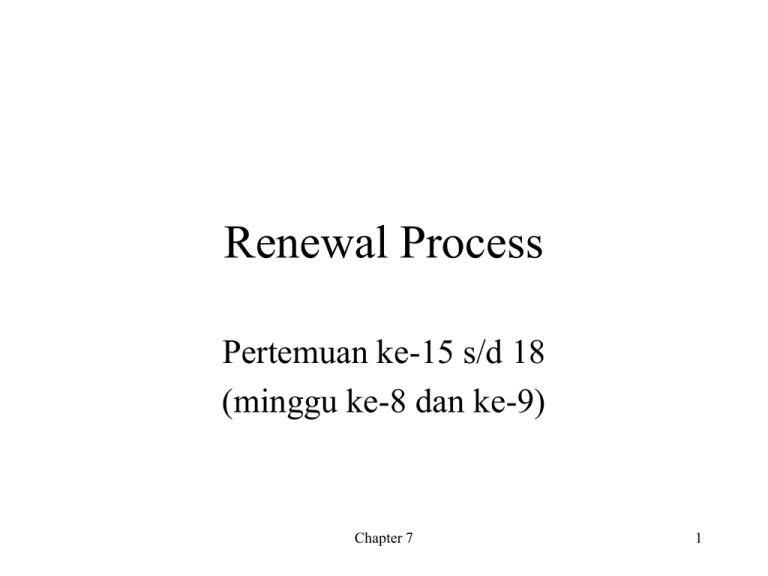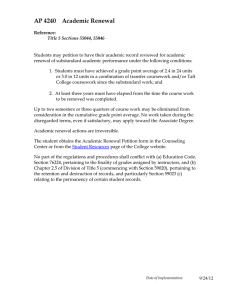Renewal Process Pertemuan ke-15 s/d 18 (minggu ke-8 dan ke-9) Chapter 7
advertisement

Renewal Process
Pertemuan ke-15 s/d 18
(minggu ke-8 dan ke-9)
Chapter 7
1
Renewal Theory
Definitions, Limit Theorems, Renewal Reward
Processes, Alternating Renewal Processes, Age
and Excess Life Distributions, Inspection Paradox
Chapter 7
2
Poisson Process:
Counting process
iid exponential
times between
arrivals
Relax
counting
process
Continuous Time
Markov Chain:
Exponential times
between transitions
Relax
Renewal Process:
exponential
interarrival Counting process
times
iid times between
arrivals
Chapter 7
3
Counting Process
A stochastic process {N(t), t 0} is a counting process if N(t)
represents the total number of events that have occurred in
[0, t]
Then {N(t), t 0} must satisfy:
N(t) 0
N(t) is an integer for all t
If s < t, then N(s) N(t)
For s < t, N(t) - N(s) is the number of events that occur in
the interval (s, t].
Chapter 7
4
Renewal Process
A counting process {N(t), t 0} is a renewal process if for
each n, Xn is the time between the (n-1)st and nth arrivals and
{Xn, n 1} are independent with the same distribution F.
n
The time of the nth arrival is Sn i 1 X i , n 1,
with S0 = 0.
Can write N t max n : Sn t
and if m = E[Xn], n 1, then the strong law of large numbers
says that S n
Note: m is now a
P m as n 1
time interval, not a rate;
n
1/ m will be called
the rate of the r. p.
Chapter 7
5
Fundamental Relationship
N t n Sn t
It follows that
P N t n P N t n P N t n 1
P Sn t P Sn 1 t Fn t Fn 1 t
where Fn(t) is the n-fold convolution of F with itself.
The mean value of N(t) is
n 1
n 1
n 1
m t E N t P N t n P S n t Fn t
Condition on the time of the first renewal to get the renewal
t
equation:
m t F t m t x f x dx
0
Chapter 7
6
Exercise 1
Is it true that:
N t n Sn t ?
N t n Sn t ?
N t n Sn t ?
Chapter 7
7
Exercise 3
If the mean-value function of the renewal process {N(t), t
0} is given by m t t 2, t 0
Then what is P{N(5) = 0} ?
Chapter 7
8
Exercise 6
Consider a renewal process {N(t), t 0} having a gamma
r 1
l x
(r,l) interarrival distribution with density
le l x
f x
e
lt
lt
i
r 1!
,x 0
(a) Show that P N t n
i!
i nr
(b) Show that
i
lt
i e lt
m t
, where x is the largest integer x
i!
i r r
Hint: use the relationship between the gamma (r,l) distribution and the
sum of r independent exponentials with rate l to define N(t) in terms of a
Poisson process with rate l.
Chapter 7
9
Limit Theorems
1
• With probability 1, N t
as t
t
m
m t
1
• Elementary renewal theorem:
as t
t
m
• Central limit theorem: For large t, N(t) is approximately
normally distributed with mean t/m and variance ts 2 m 3
where s2 is the variance of the time between arrivals;
in particular, Var N t s 2
t
m
Chapter 7
3
as t
10
Exercise 8
A machine in use is replaced by a new machine either when it
fails or when it reaches the age of T years. If the lifetimes of
successive machines are independent with a common
distribution F with density f, show that
(a) the long-run rate at which machines are replaced is
1
xf x T 1 F T
0
(b) the long-run rate at which machines in use fail equals
F T
T
T xf x T 1 F T
0
Hint: condition on the lifetime of the first machine
Chapter 7
11
Renewal Reward Processes
Suppose that each time a renewal occurs we receive a reward.
Assume Rn is the reward earned at the nth renewal and {Rn, n
1} are independent and identically distributed (Rn may
N t
depend on Xn). The total reward up to time t is R t Rn
n 1
If E R and E X
then P R t E R as t 1
t
E
X
E R
and E R t
as t
t
EX
Chapter 7
12
Age & Excess Life of a Renewal Process
The age at time t is A(t) = the amount of time elapsed since
the last renewal. The excess life Y(t) is the time until the next
SN(t)
renewal:
t
A(t)
Y(t)
A t t S N t
A t dt
What is the average value of the age lim
s
0
t
Chapter 7
s
13
Average Age of a Renewal Process
Imagine we receive payment at a rate equal to the current sage
of the renewal process. Our total reward up to time s is A t dt
0
and the average reward up to time s is
A t dt E reward during a renewal cycle
s
0
s
E length of a renewal cycle
If X is the length of a renewal cycle, then the total reward
2
during the cycle is X tdt X
0
2
So, the average age is
E X 2
2E X
Chapter 7
14
Average Excess or Residual
Now imagine we receive payment at a rate equal to the
current excess
of the renewal process. Our total reward up to
s
time s is Y t dt
0
and the average
reward up to time s is
s
Y t dt E reward during a renewal cycle
0
s
E length of a renewal cycle
If X is the length of a renewal cycle,2 then the total reward
during the cycle is X X t dt X
0
2
2
E
X
So, the average excess is (also)
2E X
Chapter 7
15
Inspection Paradox
Suppose that the distribution of the time between renewals, F,
is unknown. One way to estimate it is to choose some
sampling times t1, t2, etc., and for each ti, record the total
amount of time between the renewals just before and just after
ti. This scheme will overestimate the inter-renewal times –
Why?
For each sampling time, t, we will record X N t 1 SN t 1 SN t
Find its distribution by conditioning on the time of the last
renewal prior to time t
Chapter 7
16
Inspection Paradox (cont.)
SN(t)+1
SN(t)
0
t-s
t
P X N t 1 x E P X N t 1 x S N t t s
If s x then P X
t s P X
If s x then P X N t 1 x S N t t s 1
PX
N t 1
x S N t
N t 1
x X N t 1 s
1 F x 1 F x
s 1 F s
P X N t 1 x
N t 1
Chapter 7
17
Inspection Paradox (cont.)
SN(t)+1
SN(t)
0
t
t-s
For any s, P X N t 1 x S N t t s 1 F x
so P X
P X
x
E
x
S
t
s
N t 1
N t 1
N t
1 F x P X x
where X is an ordinary inter-renewal time.
Intuitively, by choosing “random” times, it is more likely
we will choose a time that falls in a long time interval.
Chapter 7
18

